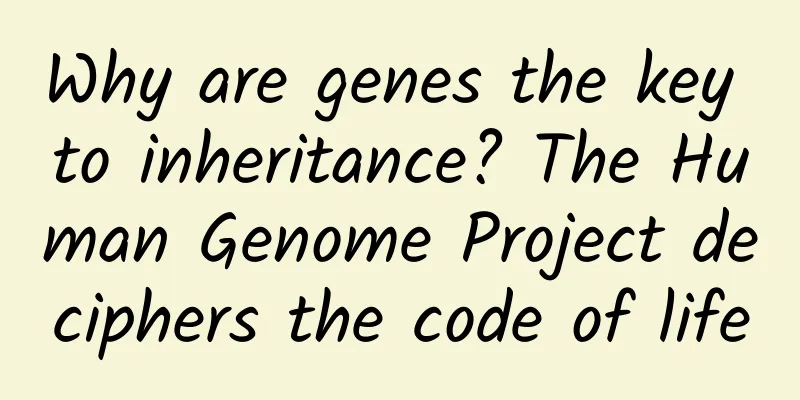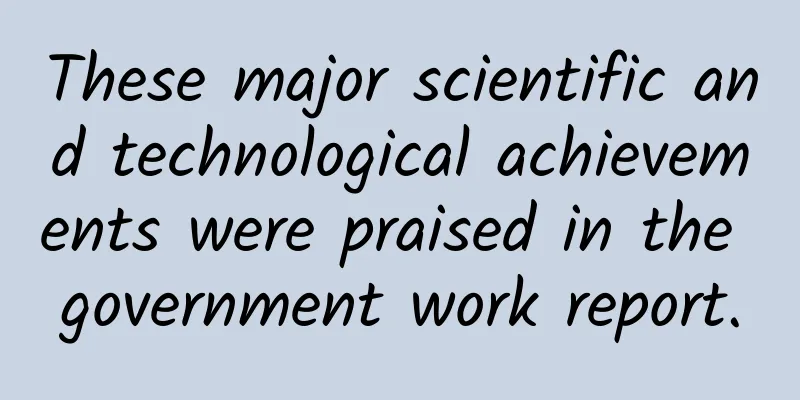Why are genes the key to inheritance? The Human Genome Project deciphers the code of life

|
Prelude to the birth of gene editing - DNA has always been a hot direction Introduction: Throughout history, there have been many discussions on the issue of heredity. From Linnaeus, Lamarck, Darwin, to Mendel, and later Watson, Crick, etc., scientists finally found the heredity secret of life: it is hidden in genes. In this video, we mainly introduce "What are genes" and "What are the effects of gene mutations". Our guest is Professor Gu Feng, a professor at the School of Medicine of Hunan Normal University and a "Xiaoxiang Scholar". Gu Feng (Professor of Hunan Normal University School of Medicine, "Xiaoxiang Scholar") | Guest Linnaeus, Lamarck, and Darwin Q: What is the relationship between genes and heredity ? Gu Feng: The question of "the relationship between genes and heredity" is a basic scientific question in genetics. For example, height is hereditary. If the parents are tall, then the height of the child will also be tall. Therefore, this is why the Nordic people are generally taller than Asians. There is a basis in genetics. Any trait in our body, including teeth, eyelids, and skin, is closely related to the genes of our parents. Mendel's pea hybridization experiment is a representative example. By hybridizing peas, we can find that there are genetic laws in the traits. Morgan's fruit fly hybridization experiment followed. Morgan did some genetic research, which laid the foundation for the further discovery of genetic genes through morphological observation. Morgan and the fruit fly experiment Of course, the scientists who finally locked on to "what is a gene" were Watson and Crick. They explained what DNA is from the perspective of DNA. The two of them explained the double helix structure and base pairing. These works laid a solid foundation for our later gene manipulation, so this is our current understanding of DNA at the genetic level. Next, let's talk about RNA. The new coronavirus is RNA. As genetic material, it can be continuously replicated and continuously passed on to the next generation. Of course, viruses are different from our conventional life forms, such as E. coli, national treasure pandas, and rice. In short, there are several important events from the initial discovery of a gene to its final determination, and these events are very important for us to promote gene editing. Q: What is the structure of genes ? Gu Feng: Genes consist of several components: First, a gene generally has a promoter that drives the transcription of the gene; second, a gene contains exons and introns. For the genome of eukaryotic cells, it contains both introns and exons. Introns separate adjacent exons, so that a gene can be transcribed into multiple different transcripts to achieve gene-specific regulation; third, in addition to the introns, exons, and promoters just mentioned, there is also a polyA structure at the 3' end of the gene, which means that transcription needs to stop at a certain position. These parts are the most basic parts of the gene. For human genes, it is mainly composed of four bases: ATGC. If it is transcribed into RNA, then T will become U, so for RNA it is AUGC. This is the difference between DNA and RNA. In addition, when we talk about genes, we usually also mention the 5' untranslated region and 3' untranslated region of the gene, which are called 5' UTR and 3' UTR respectively. For genes, these are regulatory elements, which can be transcribed at different transcription start sites and regulate the activity of gene transcription by binding certain factors through UTR. This is an important mechanism of gene regulation. Q: How do genes transmit genetic information ? Gu Feng: In the cell nucleus, let’s first talk about chromosomes. Genes are located in a certain section of a chromosome. Genes replicate as cells are renewed, which involves the issue of DNA replication. There is also a corresponding process for the replication of mother cells into daughter cells, which is called mitosis. Then, there is the process of how genes act on proteins in our body. This process includes transcribing genes into RNA by RNA polymerase, and then RNA needs to be transported from the nucleus to the cytoplasm, which involves relevant base pairing. After the RNA is transcribed, it needs to become mature RNA. Mature RNA needs to be transported from the nucleus to the cytoplasm, and finally translated using nucleic acids in the cytoplasm. After the translation is completed, the protein will go to the nucleus. If it needs to go to the mitochondria, it will have a mitochondrial localization signal to make it go to the mitochondria; if it needs to stay in the cytoplasm, it will be located in the cytoplasm. Of course, protein modification may also be involved here, and different protein modifications can regulate protein activity. For example, protein itself is an enzyme, and we can regulate protein activity through different modifications such as phosphorylation and acetylation. If there are proteins that are produced, there will naturally be proteins that are degraded. If we don't want a particular protein, we can break it down through ubiquitination. Ultimately, this will be a dynamic process. If there is a problem in this dynamic process, for example, our genes mutate, then the corresponding proteins will also mutate. For example, if a protein itself should go to the cell nucleus, but it cannot reach there after mutation, then it will have a functional impact on the cell. Q: What is a genetic mutation? Gu Feng: Regarding the issue of gene mutation, it actually has two effects. On the one hand, mutation may make us better. For example, after mutation, malarial parasites cannot infect us, or the infection rate is very low. We should not completely think that mutation is necessarily bad. It is even possible that mutation makes us smarter. On the other hand, mutations may also cause us to suffer from diseases. Mutations may have positive or negative effects, just like vaccines. In the process of making vaccines, we may reduce the toxicity of microorganisms and make safer and more effective vaccines. There are several different theories about how mutations occur in the human body. First, mutations occur during the production of sperm and eggs, because during meiosis, the genome as a whole changes greatly, and mutations are likely to occur when homologous recombination occurs during meiosis. Second, mutations mainly occur in the reproductive organs. We found that neither parent had mutations, but their children did. We call this type of mutation "de novo mutation". In "de novo mutation", the father's influence is very large. The older the father is, the more mutations the child will have, which is the influence of the father. Similarly, the mother's source also has a certain influence, for example, meiosis occurs during the egg generation process, and related mutations are prone to occur during the meiosis process. Third, some exogenous factors, such as radiation and ion radiation in space, as well as some drugs, microorganisms, and especially viruses, which will be integrated into the genome and eventually lead to related diseases. For example, hepatitis B eventually leads to liver cancer because it destroys our genes. Q: Can you tell us about the Human Genome Project ? Gu Feng: The Human Genome Project, as the name implies, is to determine the base structure of the human genome. For example, it determines the location and composition of genes. This work began in the late 1990s and was completed during Clinton's presidency of the United States. The human genome is composed of about 3 billion bases. At that time, the investment was one dollar per base, which means a total of 3 billion US dollars was invested in the hope of clarifying the human genome. Once we understand the genome, it will be of great significance to the diagnosis and treatment of subsequent diseases. In our country, Academician Yang Huanming participated in the "Human Genome Project" at that time. This work was of great significance. Of course, this project made contributions on the one hand, but on the other hand, due to the limitations of technology at that time, the determination of some genome bases was not very clear. In the past two years, technology has improved, and researchers have updated some unclear sequences. The Human Genome Project is very important to our entire life sciences. In this process, we not only cultivated a group of talents, but also improved our ability to collaborate internationally, which is a milestone contribution to the entire discipline. Q: What is the impact of the Human Genome Project? Gu Feng: The historical contribution of the Human Genome Project is very great, because we must first understand things before we can talk about transforming things. So reading, writing, and modifying (genes) are actually a unified process. If the genes cannot be read clearly, it is impossible to write and modify (genes). The Human Genome Project has provided a very solid foundation for the entire discipline. A few days ago, when I was chatting with Academician Li Jinsong of the Institute of Biochemistry and Cell Biology of the Chinese Academy of Sciences about scientific research, he told me that their laboratory is doing a study to label every gene of mice. This work is very meaningful and can be used as a good tool. This plan is actually somewhat related to the "Human Genome Project". When we use mice to do some research, we often lack relevant tools and genetic resources, which are all extensions of the "Human Genome Project". It does not mean that the Human Genome Project is over and genome research is over. In fact, there is still a lot of follow-up work to be done. Therefore, good genetic resources, good related technology platforms, and batches of talent training are very important for the entire life sciences. This article is a work supported by Science Popularization China Starry Sky Project Interviewer: Ye Shuisong Interviewee: Gu Feng Reviewer: Tao Ning, Associate Researcher, Institute of Biophysics, Chinese Academy of Sciences Produced by: China Association for Science and Technology Department of Science Popularization Producer: China Science and Technology Press Co., Ltd., Beijing Zhongke Xinghe Culture Media Co., Ltd. |
<<: After receiving the university admission letter, you must read this
Recommend
The "domestic" Tesla Model 3 has been shipped out of the Shanghai factory and is expected to be delivered before the end of January 2020
Recently, foreign media reported that Tesla Model...
In the history of chemistry, there are 3 diamonds that make people laugh and cry
Diamond is the hardest substance known in nature....
Is there really life on Venus?
Last year, scientists from the Royal Astronomical...
An 8,000-word summary that explains the secrets of 10 high-conversion detail pages!
At present, there are already many articles on th...
The sky-high-priced toilet in space - learn how to aim it to use it
What is this year? As long as the word "spac...
SAIC Motor’s public statement on the EU Commission’s anti-subsidy duty decision
Dear global customers, partners and media friends...
Banmeng Portrait Photography Online Class 4th Session 2020
Banmeng Portrait Photography Online Class 4th Ses...
More professional Android console, Chieftain gaming console first unboxing
On January 6, the highly anticipated Big Chief ga...
Operation: What should B-side products do in the initial cold start phase?
"Cold start" has become a hot topic for...
Have you ever used the black technology code? The god-like automatic code app
When we share screenshots, we usually block out o...
A complete analysis of Pinduoduo’s operating model and methods
Let’s talk about Pinduoduo today. New Market In t...
How much does it cost to renovate a second-hand house in Lanzhou? How much does it cost per square meter to renovate an old house?
Unlike new houses, second-hand houses require mor...
Deadly and fatal! Is the "beautiful killer" in the ocean also an excellent doctor?
Produced by: Science Popularization China Author:...
Is the Internet of Things really about to be realized?
[[125949]] Recently, Samsung President and CEO BK...
This brain-burning thought experiment challenges quantum mechanics
As the most famous cultural symbol of quantum mec...









